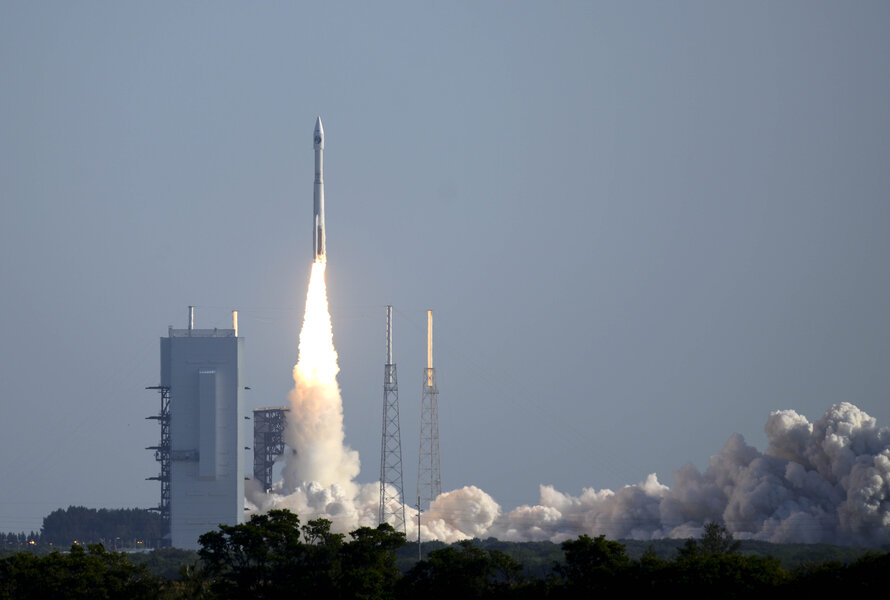SpaceX's rival ramps up plans with 'space trucks'
Ever since NASA began contracting with commercial companies to get cargo to the International Space Station (ISS), SpaceX has been the face of commercial space shipping, despite several prominent competitors. Now, the company may have a serious rival.
Tony Bruno, chief executive officer of the United Launch Alliance (ULA), a partnership between aerospace engineering companies Lockheed Martin and Boeing, discussed the company’s plans to create a cargo carrier that he nicknamed the “space truck” with news outlet Quartz this week.
Does this signal a shift towards greater specialization in the space engineering market?
SpaceX is not the only company sending shipments of food, experiments, and other supplies to the international space station, but it is the best known – and offers a significantly lower cost. The company’s successful quest to create a reusable rocket has prompted rivals to aggressively seek ways to lower their costs.
The United Launch Alliance is one of those rivals. The company’s launch contract with NASA is due to expire in 2019, meaning that ULA needs to innovate to remain relevant.
Mr. Bruno’s vision for ULA’s future is expansive, and includes plans for space infrastructure that can support lunar colonization by 2020. To that end, the company’s current project aims to make it cheaper and easier to get into space.
Like SpaceX, ULA hopes to achieve its aims by developing a reusable rocket. According to Bruno, unlike rival SpaceX, ULA’s rocket will have a reusable second stage (the portion of the rocket that finishes the journey) as well as a reusable first stage (the stage that propels the rocket from Earth into orbit).
And unlike SpaceX, which has developed the technology to bring reusable rockets back to Earth, ULA plans to leave the reusable second stages in space.
“We realized that you don’t have to bring it back in order for it to be reusable,” Bruno told Quartz “That’s the big paradigm change in the way that you look at the problem – if you have an upper stage that stays on orbit and is reusable.”
ULA’s second stage design looks like a fuel tank, and can be refueled and reloaded while still in orbit, where it would wait for cargo loads sent up from Earth. Due to the relief rockets (ULA’s “space trucks”) waiting in orbit, a cargo load could be incredibly heavy and still be able to make it to its final destination, whether that be a lunar colony or the ISS.
Once you have these second stage fuel capsules in space, Bruno says, “It starts becoming practical to construct large-scale infrastructure and support economic activities in space, a transportation system between here and the moon, practical microgravity manufacturing, commercial habitats, prospecting in the asteroids.”
As of last year, ULA also had plans to develop a reusable first stage Vulcan rocket that could be recovered in mid-air. As with its most recently announced second-stage plan, the company placed cost-effectiveness at a premium, with senior staff engineer Mohamed Ragab telling SpaceNews:
“If you work the math, you see that you’re carrying a lot of fuel to be able to bring the booster back and it takes much longer to realize any savings in terms of the number of missions that you have to fly – and they need to be all successful.”
While there are several other companies with commercial space ambitions and Silicon Valley interest, they are lesser known entities such as Moon Express and Planetary Resources.
Much of today’s space innovation is occurring at the commercial level, making it ever more valuable for companies such as ULA and SpaceX to specialize.
On Thursday, ULA announced that it has been chosen by NASA to launch the next Mars rover exploration project in 2020. Even the ISS could soon be commercially run.
"Ultimately, our desire is to hand the space station over to either a commercial entity or some other commercial capability,” said NASA’s deputy associate administrator for exploration systems development Bill Hill last Sunday, “so that research can continue in low-earth orbit, we figure that will be in the mid-20s."






